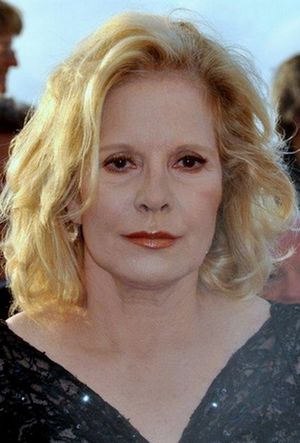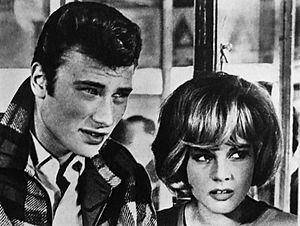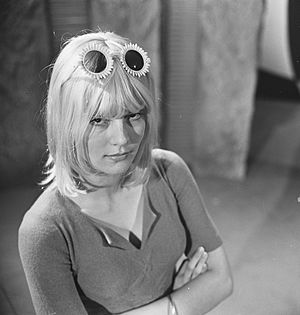Sylvie Vartan facts for kids
Quick facts for kids
Sylvie Vartan
|
|
|---|---|
| Силви Вартан | |

Vartan at the 2011 Cabourg Film Festival
|
|
| Born |
Sylvie Georges Vartanian
15 August 1944 Iskrets, Kingdom of Bulgaria
|
| Spouse(s) |
|
| Children | 2, including David Hallyday |
| Relatives |
|
| Musical career | |
| Origin | Paris, France |
| Genres |
|
| Occupation(s) |
|
| Years active | 1952–present |
| Labels | |
Sylvie Vartan (born Sylvie Georges Vartanian on 15 August 1944) is a famous Bulgarian-French singer and actress. She is known as one of the most popular yé-yé artists. Yé-yé was a style of pop music that was very popular in France in the 1960s.
Sylvie Vartan's shows often included exciting dance routines. She appeared many times on French and Italian TV. Her yearly shows with her husband at the time, Johnny Hallyday, filled big venues in Paris during the 1960s and 1970s. After a break, she started recording and performing jazz songs in French-speaking countries and Japan in 2004.
Contents
Early Life and Family
Sylvie Vartan was born in Iskrets, a town in Bulgaria. Her father, Georges Vartanian, was born in France. His mother was Bulgarian and his father was Armenian. He worked at the French embassy in Sofia. The family later shortened their last name to Vartan. Sylvie's mother, Ilona, was of Hungarian-Jewish background. Her father was a well-known architect.
When the Soviet Army arrived in Bulgaria in September 1944, the Vartanian family's house was taken over by the government. They then moved to Sofia. In 1952, a friend of Sylvie's father, film director Dako Dakovski, offered her a small role. She played a schoolgirl in the movie Pod igoto. Being in the film made her dream of becoming an entertainer come true.
Life was difficult in Bulgaria after the war. Because of this, her family moved to Paris, France, in December 1952. At first, they stayed in a hotel in Paris. Her father found a job there. For the next four years, they lived in just one room at another hotel. Young Sylvie worked hard at school to fit in with her new classmates. It took her two years to learn French well.
In 1960, her family moved to an apartment in Paris. Sylvie's older brother, Eddie Vartan, was a music producer. Because of his influence, music became Sylvie's main interest as a teenager. She loved jazz and rock 'n' roll. Some of her favorite singers were Brenda Lee, Bill Haley, and Elvis Presley.
Music Career
Becoming a Star
In 1961, Eddie Vartan gave Sylvie a chance to record a song. It was called "Panne d'essence" with French rocker Frankie Jordan. This song became a surprise hit. Even though her name wasn't on the record cover, "Panne d'essence" led to Sylvie's first appearance on French television. Journalists gave her the nickname la collégienne du twist, which means "the twisting schoolgirl."
After finishing high school, Sylvie signed a contract with Decca Records. She started recording her own songs. Her first record, with the song "Quand le film est triste," came out in December 1961. This was another hit. It led to her first concert at the Paris Olympia Hall on 12 December 1961. She quickly released another song, "Est-ce que tu le sais?", which was her version of Ray Charles' "What'd I Say".
In July 1962, she toured France with Gilbert Bécaud. That autumn, she released her version of "The Loco-Motion" and her first full album, Sylvie. Her next big hit was "Tous mes copains" in 1962. She also had a small role as a singer in the movie Un clair de lune à Maubeuge. In 1963, Paul Anka gave her the song "I'm Watching You." This became her first international hit in Japan and Korea. She ended the year with four TV specials and became very popular with the teen magazine Salut les Copains. Six of her songs released in 1962 and 1963 became Top-20 hits in Europe.
In early 1963, Vartan toured France with Johnny Hallyday. They also starred together in the movie D'où viens-tu, Johnny?. Later, they announced their engagement on the radio. The young couple performed for a huge crowd of 200,000 people in Paris. At the end of the year, they traveled to Nashville, Tennessee, in the USA. There, they recorded an album with The Jordanaires. These recordings were very successful in France.
The album Sylvie à Nashville included the hits "La plus belle pour aller danser" and "Si je chante". It also had three new songs in English. The song "La plus belle pour aller danser" became number one in France. It sold over a million copies in Japan and was very popular in Korea and Spain. It was also her first song released in Italy. In January 1964, she performed at the Paris Olympia. She was one of the opening acts for the Beatles.
Sylvie's fame grew even more with a commercial for "Renown" clothing and a role in the film Patate. She also appeared on popular American TV shows like The Ed Sullivan Show and Shindig!. She went on an international concert tour, visiting Canada, South America, and Polynesia. In Tokyo, she performed 13 concerts in just 12 days.
Yé-yé Era and Beyond
In December 1964, Johnny Hallyday went into military service. Sylvie's brother Eddie hired two English musicians, Tommy Brown and Mick Jones. They went to New York to record. They wrote her the hit song "Cette lettre-là." On 16 January 1964, Sylvie performed with The Beatles, opening their show at Olympia. "Cette lettre-là" was the first of Sylvie Vartan's many TV variety show performances. In 1966 and 1967, she recorded more original hits. "Dis moi, que tu m'aimes" was shown on TV on 9 July 1967. "Le jour qui vient" was aired in color on 14 January 1968. "2'35 de bonheur" and "Comme un garçon" were other number one hits in France, Italy, Belgium, Japan, and Korea.
On 11 April 1968, Sylvie Vartan was injured in a car accident. However, she was back on tour by August. She showed off a new, more grown-up image on French TV in the "Jolie poupée" show on 4 December 1968. This show was very entertaining. It included her performance of "Irrésistiblement" with many dancers. It also featured "Jolie Poupée," a song where she talked to a doll version of herself.
The popular songs from the "Jolie poupée" show were released as the Maritza album. In Italy, she released her own version of Mina's "Zum zum zum." Vartan's version did better on the Italian charts than Mina's original. Vartan continued her one-woman shows at the Paris Olympia in December 1968. These shows were later made into a documentary called Sylvie à L'Olympia.
For nine Saturday nights in 1969, Vartan starred in the Doppia coppia variety shows in Italy. She sang her hits "Irrésistiblement" and "Le jour qui vient" in Italian. In March 1969, "Irresistibilmente" quickly became a top song in Italy. It stayed in the Top Ten for 10 weeks. The gentle song "Blam blam blam," written just for Doppia coppia, also became popular in Italy.
After her world tour in autumn 1969, she returned to Italy. She performed on TV shows like Canzonissima and Incontro con Sylvie Vartan. Her appearances were very popular in both Italy and France. She wore a different costume for each song, often including short skirts and cool boots. Cartoonists in both countries even drew characters that looked like Sylvie Vartan.
1970s to Today
Sylvie Vartan had another serious car accident in 1970. Despite this, she kept performing and recording many songs. In 1972, she starred in the film Malpertuis. She sold millions of records for the RCA label. This made her their most successful artist after Elvis Presley. Some of her most famous songs from this time include "J'ai un probleme," "L'amour au Diapason," "Parle moi de ta vie," "Petit rainbow," "Bye Bye Leroy Brown," "Disco Queen," "Nicolas," and "Caro Mozart." Her yearly world tours and Italian TV shows continued to feature her biggest hits from the late 1960s.
In 1976, she recorded "Qu'est-ce qui fait pleurer les blondes?" This was a disco-style song that was number one in France for several weeks. Her disco period reached its peak with the Dancing star TV show on TF1 in September 1977. RCA released the show as the Dancing star album. After a week of concerts in Las Vegas in 1982, she released a duet with John Denver called "Love Again." In 1985, she released a new album in the US with songs like "Double Exposure." In 1986, she took a break from performing. She returned in 1989 with "C'est Fatal."
In 1990, Vartan gave a concert in Sofia, Bulgaria. She opened and closed the show with a Bulgarian song. This was her first visit to the city since her family moved away.
In 1991, she performed for three weeks in Paris and had a hit song called "Quand tu es là." In 1995, she starred in "L'ange noir." In 1996, Sylvie recorded a successful album called "Toutes les femmes ont un secret." It included the song "Je n'aime encore que toi." After her brother Eddie passed away in 2001, she took another break from public performances. In late 2004, Vartan started recording and performing jazz songs in French-speaking countries and Japan. She performed for two weeks at the Palais des congrès in 2004 and 2008, and all her concerts were sold out. In 2009, she toured many countries, including Turkey, France, Japan, and the USA.
Achievements and Recognition
In 2005, Sylvie Vartan was named a WHO Goodwill Ambassador. This role means she helps promote maternal and child health in Europe. Vartan is also seen as a gay icon.
Awards and Honors
- Chevalier (Knight) of the Ordre national du Mérite in 1987, and Officier (Officer) in 2006.
- Chevalier (Knight) of the Legion of Honour in 1998, and Officier (Officer) in 2009.
Personal Life

In 1962, Sylvie Vartan met pop-rock singer Johnny Hallyday during her second concert in Paris. They got married on 12 April 1965. They had a son named David Michael Benjamin Smet, who later became known as David Hallyday. Sylvie Vartan and Johnny Hallyday were considered the "golden couple" in France. Their marriage was closely watched by the public. However, they had many disagreements, and they divorced on 4 November 1980.
Later, Vartan married record producer Tony Scotti. They adopted a young Bulgarian girl named Darina. Sylvie Vartan is also the aunt of American actor Michael Vartan. He is the son of her older brother Eddie Vartan.
Discography
- Sylvie (1962)
- Twiste et chante (1963)
- Sylvie a Nashville (1964)
- A gift wrapped from Paris (1965)
- Il y a deux filles en moi (1966)
- 2'35 de bonheur (1967)
- Comme un garçon (1967)
- La Maritza (1968)
- Aime-moi (1970)
- Sympathie (1971)
- Untitled (J'ai un problème) (1973)
- Je chante pour Swanee (1974)
- Shang shang a lang (1974)
- Qu'est-ce qui fait pleurer les blondes? (1976)
- Sylvie Vartan (Ta sorcière bien-aimée) (1976)
- Georges (1977)
- Dancing Star (1977)
- Fantaisie (1978)
- I Don't Want the Night to End (1979)
- Déraisonnable (1979)
- Bienvenue solitude (1980)
- Ça va mal (1981)
- De choses et d'autres (1982)
- Danse ta vie (1983)
- Des heures de désir (1984)
- Made in USA (1985)
- Virage (1986)
- Confidanses (1989)
- Vent d'ouest (1992)
- Sessions acoustiques (1994)
- Toutes les femmes ont un secret (1996)
- Sensible (1998)
- Sylvie (2004)
- Nouvelle vague (2007)
- Toutes peines confondues (2009)
- Soleil bleu (2010)
- Sylvie in Nashville (2013)
- Une vie en musique (2015)
- Avec toi (2018)
- Merci pour le regard (2021)
Filmography
- Pod igoto (1952), based on the novel by Ivan Vazov (Under the Yoke)
- Un clair de lune à Maubeuge (1962)
- Cherchez l'idole (1963)
- D'où viens-tu, Johnny? (1964)
- Patate (1964)
- Malpertuis (1971)
- L'ange noir (1994)
- Mausolée pour une ... (2001) (TV)
- The Missionaries (2014)
- Ma mere, Dieu et Sylvie Vartan (2025)
See also
 In Spanish: Sylvie Vartan para niños
In Spanish: Sylvie Vartan para niños




